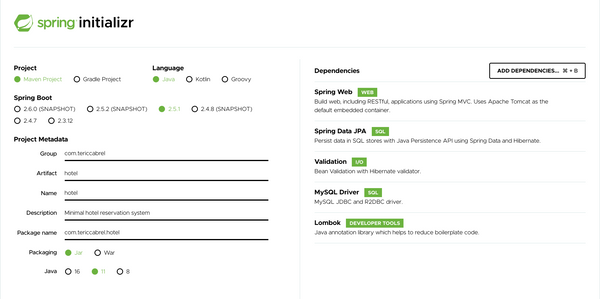

SPRING BOOT VALIDATION ANNOTATIONS FREE
In addition, we can test the REST controller API using a free API life cycle testing application, such as Postman. I want to apply Validated and Valid for verifying user input of an HTTP request: import .Validated import //. The best way to understand how it works as well as how we can use custom annotations for validation is to create simple use cases and try to understand how it works. andExpect(MockMvcResultMatchers.jsonPath("$.name", Is.is("Name is mandatory"))) Spring Boot Annotations While I was working on a Spring Boot Project, I found that custom annotations were being used for validation. andExpect(MockMvcResultMatchers.status().isBadRequest()) In this next tutorial, well focus on building validations for enums using custom annotations.
SPRING BOOT VALIDATION ANNOTATIONS HOW TO
And in the tutorial Spring MVC Custom Validation, we saw how to create custom validations. contentType(MediaType.APPLICATION_JSON_UTF8)) Introduction In the tutorial Java Bean Validation Basics, we saw how we can apply javax validations using JSR 380 to various types. MockMvc.perform(MockMvcRequestBuilders.post("/users") Let's look at the REST controller implementation: class UserController User user) " Spring Boot makes this seemingly complex process really simple through the implementation of a REST controller. Therefore, we can validate them and perform a few further tasks, depending on the validation results. Of course, we need to implement a layer that allows us to get the values assigned to our User object's constrained fields. Since we'll use Spring Data JPA for saving users to the in-memory H2 database, we also need to define a simple repository interface for having basic CRUD functionality on User objects: For further information, please read the official bean validation docs. Therefore, when Spring Boot validates the class instance, the constrained fields must be not null and their trimmed length must be greater than zero.Īdditionally, Bean Validation provides many other handy constraints besides This allows us to apply and combine different validation rules to the constrained classes.

Also, we specified the error messages with the message attribute. It is performed by applying constraints on data items. The demonstrated examples are simple and do not represent real-world scenarios, but Spring Security provides a rich set of annotations, and you can handle a. The implementation of our User entity class is pretty anemic indeed, but it shows in a nutshell how to use Bean Validation's constraints to constrain the name and email fields.įor simplicity's sake, we constrained the target fields using only the constraint. Java Bean Validation API is a set of interfaces and annotations used to simplify data validation. The option is a type.// standard constructors / setters / getters / toString To use a a custom ValidationProviderResolver. The option is a type.Ĭ-provider-resolver Beware that when the first message is processed then creating and starting the producer may take a little time and prolong the total processing time of the processing.Ĭ-interpolator Validating BigDecimal Instances Unfortunately, with BigDecimal, we cant use the classic Min or Max javax annotations, as they only accept long values. By deferring this startup to be lazy then the startup failure can be handled during routing messages via Camel’s routing error handlers. And thanks to Spring Boot which applies automatic configuration, we don’t have configure anything to use Java Bean validation API. For the complete list of Java Bean Validation annotations, see this page. By starting lazy you can use this to allow CamelContext and routes to startup in situations where a producer may otherwise fail during starting and cause the route to fail being started. All these annotations come from the package. To override the access level, annotate the field or class with an explicit Setter and/or Getter annotation. Whether the producer should be started lazy (on the first message). All generated getters and setters will be public. Whether to ignore data from the META-INF/validation.xml file.Ĭ-start-producer This is enabled by default.Ĭ-xml-configuration Whether to enable auto configuration of the bean-validator component. The constraint annotation is decorated with a couple of meta annotations. To use a custom ConstraintValidatorFactory. An annotation type is defined using the interface keyword. This can be used for automatic configuring JDBC data sources, JMS connection factories, AWS Clients, etc.Ĭ-validator-factory This is used for automatic autowiring options (the option must be marked as autowired) by looking up in the registry to find if there is a single instance of matching type, which then gets configured on the component.


 0 kommentar(er)
0 kommentar(er)
